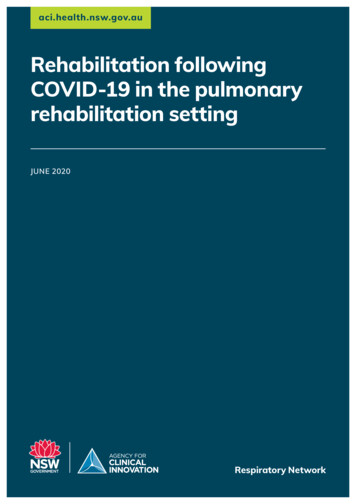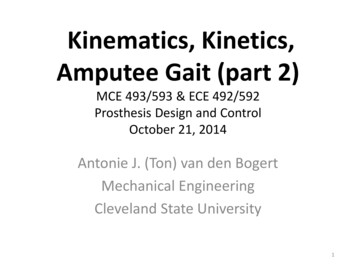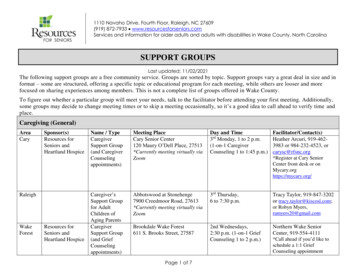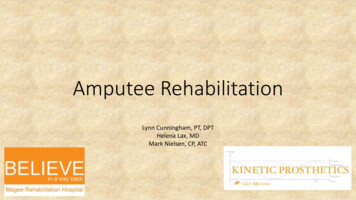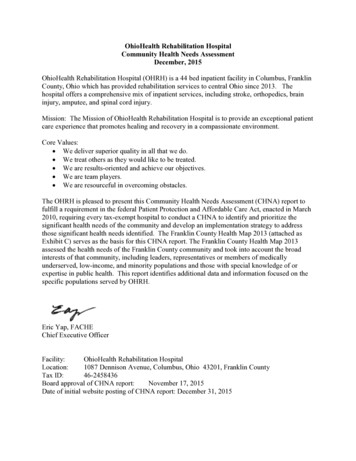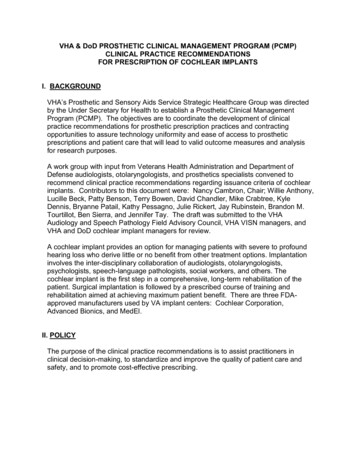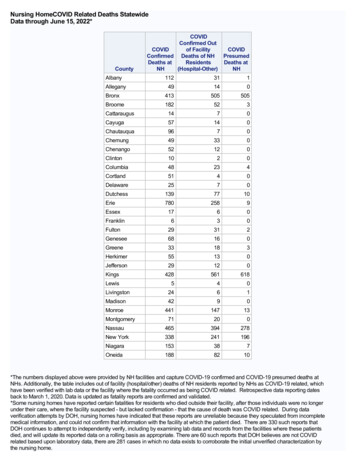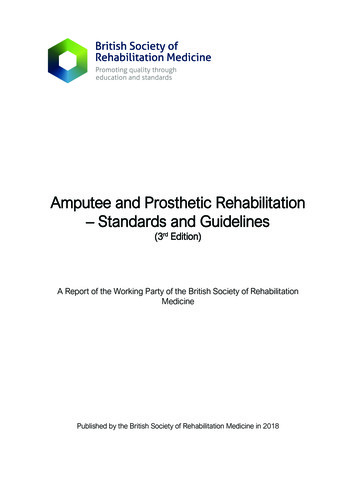
Transcription
Amputee and Prosthetic Rehabilitation– Standards and Guidelines(3rd Edition)A Report of the Working Party of the British Society of RehabilitationMedicinePublished by the British Society of Rehabilitation Medicine in 2018
Amputee and Prosthetic Rehabilitation– Standards and Guidelines(3rd Edition)A Report of the Working Party of the British Society of RehabilitationMedicineCo-Chairs: Professor Rajiv Hanspal & Dr Imad SedkiPublished by the British Society of Rehabilitation Medicine2018(registered charity number 293196)The British Society of Rehabilitation Medicine (BSRM) is the society which representsthe specialty of Rehabilitation Medicine. It promotes an understanding of the specialtythrough education and the development of clinical guidelines and standards.Membership is open to all registered medical practitioners interested and concernedwith its objectives.Further information and copies of this report can be obtained from:The British Society of Rehabilitation MedicineC/o Royal College of Physicians11 St Andrews PlaceLondon NW1 4LE 01992 638865www.bsrm.org.uk
Recommended citationBritish Society of Rehabilitation Medicine. Amputee and Prosthetic Rehabilitation – Standards andGuidelines, 3rd Edition; Report of the Working Party (Co-Chairs: Hanspal RS, Sedki I). British Societyof Rehabilitation Medicine, London 2018.ISBN: 978-0-9927275-1-2Please note: Revisions to this guidance may be made in the event of changes to NHSEngland/government policies/directives – updates will in the first instance be published on-line atwww.bsrm.org.uk
Amputee and Prosthetic RehabilitationStandards and Guidelines (3rd Edition)Membership of the Working PartyCo-Chairs:Professor Rajiv HanspalDr Imad SedkiMembers:Dr Bhaskar BasuDr Moheb GaidDr Lorraine GrahamDr Fergus JepsonProfessor Jai KulkarniConsultees:Ms Laura Burgess (Physiotherapist/consultee)Dr Keren Fisher (Clinical Psychologist/consultee)Mr Steve McNeice (User/consultee)Dr Alan Mistlin (Defences Medical Rehab Centre/consultee)Mr John Sullivan (Prosthetist/consultee)Ms Clare Tamsitt (Manager/consultee)Ms Carolyn Young (Commissioner/consultee)Professor Sir Saeed Zahedi OBE (ISPO Chair/consultee)Ms Melissa Jacobs – (Occupational Therapist/consultee)Full details of working party members and consultees are in Appendix 1.AcknowledgementsThe Working Party are grateful to all participants of the consultation process without whom it wouldnot have been possible to develop these updated standards and guidelines. The assistance of theBSRM’s Special Interest Group for Amputee Medicine (SIGAM) was particularly valuable in updatingthe standards themselves. SIGAM is the Society’s special interest group for membersinterested/working in the field of Amputee Medicine Chaired by Professor Jai Kulkarni (2009-12),Dr Imad Sedki (2012-15) and Dr Lorraine Graham (2015-2108).BSRM Working Party Report – Amputee and Prosthetic Rehabilitation – Standards and Guidelines (3rd Edition)1
BSRM Working Party Report – Amputee and Prosthetic Rehabilitation – Standards and Guidelines (3rd Edition)2
ForewordI am delighted to write this Foreword to the updated (3rd) edition of the Amputee andProsthetic Rehabilitation – Standards and Guidelines. This is particularly pertinent as theWorld Health Organisation’s own standards for prosthetics and orthotics provided a valuableresource to the British Society of Rehabilitation Medicine (BSRM) working group and playeda key role in this updated document.Despite differing health service structures throughout the world, the similarities anduniformity in the underlying recommended standards and guidelines internationally arestriking. The objective of this document is to ensure people receive the best quality ofprosthetic rehabilitation and other allied health services to remain independent, productiveand healthy by maintaining a basis upon which a service of excellence can be delivered to allthose with limb loss. Access to all forms of assistive technology is the thrust of the WHO’sGlobal Co-operation of Assistive Technology (GATE) Initiative and Prosthetics is an essentialpart of assistive technology.The importance of standards both national and international should not be underestimatedand this 3rd edition of ‘Amputee and Prosthetic Rehabilitation – Standards and Guidelines’provides a valuable tool for both commissioners and providers of services in the UK andbeyond.Chapal KhasnabisProgram Manager – Global Co-operation of Assistive TechnologyDepartment of Essential Medicines and Health ProductsWorld Health OrganisationBSRM Working Party Report – Amputee and Prosthetic Rehabilitation – Standards and Guidelines (3rd Edition)3
BSRM Working Party Report – Amputee and Prosthetic Rehabilitation – Standards and Guidelines (3rd Edition)4
Contents1. IntroductionOverall objective of the standardsTarget audienceThe patient groupThe third editionMethodsReferences2. History777788911References3. EpidemiologyReferences4. Services for limbless peopleSpecification of Prosthetic and Amputee Rehabilitation Centres (PARCs)Prosthetic and Amputee Rehabilitation Centres (PARCs)Composition of the TeamReferences5. Lower limb amputationPre-amputationAmputationPrimary prosthetic amputee rehabilitationAmputee review and maintenanceReferences6. Upper limb amputationRehabilitationAcquired upper limb loss - pre-amputationAcquired upper limb loss - amputationAcquired limb loss - post amputationProsthetic phase (if applicable)Review and maintenance phaseReferences7. Congenital limb 414145Role of the local hospitalRole of the Limb Deficiency Clinic (at PARC)Other specialistsProsthetic treatmentEducationAdolescenceAdult lifePhantom sensations and painReferences4545464748484849508. Rehabilitation following traumatic limb loss53The role of Rehabilitation Medicine following traumatic limb lossGuidance following traumatic limb lossThe Rehabilitation Prescription (RP)Coordinated care and interdisciplinary workingProsthetic limb prescription5353535455BSRM Working Party Report – Amputee and Prosthetic Rehabilitation – Standards and Guidelines (3rd Edition)5
9. Care for Veterans with amputationsRecommendations and scope of provision of prosthetics for ex-servicemen withservice attributable injury10. Miscellaneous topicsCounsellingOutcome MeasuresCosmesisLimbs for LeisureWater Activity Limbs57616162666869Section IIStandards for Amputee and Prosthetic Rehabilitation (3rd Edition)71APPENDICES79Appendix 1 – Membership of the Working PartyAppendix 2 – Glossary of termsAppendix 3 - Useful addressesBSRM Working Party Report – Amputee and Prosthetic Rehabilitation – Standards and Guidelines (3rd Edition)657798183
Introduction1. Introduction1.1The British Society of Rehabilitation Medicine (BSRM) is the Society which represents the specialtyof Rehabilitation Medicine. It promotes an understanding of the specialty through the education anddevelopment of clinical standards and guidelines. The Special Interest Group for Amputee Medicine(SIGAM) represents members of the BSRM with an interest in Prosthetic and AmputeeRehabilitation.1.2The BSRM is devoted to:1.3 Promoting the development and good practice of Rehabilitation Medicine as a medicalspecialty Enhancing undergraduate and postgraduate education in rehabilitation and disability issues Supporting rehabilitation research Liaising with related medical, paramedical and voluntary organisations to further these aims.The BSRM recognises that certain areas of service, including Prosthetics and AmputeeRehabilitation, require their own specific set of standards. In 2003, the BSRM published the secondedition of the Amputee and Prosthetic Rehabilitation Standards and Guidelines.1Overall objective of the standards1.4The standards are based on the best-published evidence or agreed national guidelines and policieswhenever possible in order to maximise the mobility, independence and quality of life of amputeesand individuals with congenital limb deficiencies.1.5The overall objective of the standards and guidelines is to establish a basis for the provision of aservice of excellence to the amputee population, both users of prostheses and non-users, with equityof access throughout the UK.1.6This document also aims to assist clinical governance and service development with standardspresented in a format easily accessible for audit purposes.Target audience1.7These standards are targeted towards the range of professionals involved in the management ofpeople with acquired and congenital limb loss, including: Doctors and Allied Health Professionals, including referring clinicians, involved in the clinicalmanagement of people with limb loss Commissioners, service providers and managers of these services Manufacturers who supply the prosthetic hardware and other equipment prescribed by theseservices Voluntary and charitable organisations that work with these services.The patient group1.8The patient group includes all patients who have an acquired limb loss or congenital limb deficiency,irrespective of age or aetiology and patients for whom amputation may be considered as a treatmentoption.BSRM Working Party Report – Amputee and Prosthetic Rehabilitation – Standards and Guidelines (3rd Edition)7
IntroductionThe third edition1.9It is now 15 years since the publication of the revised Amputee and Prosthetic RehabilitationStandards and Guidelines Report.1 Many changes and developments to national services foramputees have occurred; these include increasing roles in different disciplines, enhancedmultidisciplinary collaborations and a rapid expansion of technical aspects.1.10However, this also corresponds with many challenges such as a palpable decline in availableresources and higher expectations of prosthetic users.2 The London Paralympic Games focused avery positive light on disability in general and prosthetic users in particular, it brought changes tosociety’s attitudes and further raised users’ expectations. The publication of the Murrison Report 3and the recent efforts to facilitate the transition of amputee veterans from military rehabilitationservices to the NHS are considered as a great opportunity to improve the level of servicesnationwide. Nevertheless, the transfer of the veterans to the NHS prosthetic service also adds manychallenges, including concerns of creating a two-tier system and the inability of the NHS to meet thecomplex needs and high expectations of some veterans. The agreed mechanism for funding ofmicroprocessor prosthetic knees (MPKs) by NHS England has been a very welcome improvementfor some prosthetic users. The MPK policy4 was approved in Dec 2016 with immediate effect, makingMPKs available to hip disarticulation, trans-femoral amputees under specific qualifying criteria andindications.1.11Other significant changes include: funding prosthetic services in England through the NHS SpecialistCommissioning Board from April 2013 and subsequent development of national servicespecifications,5 workforce changes in training numbers and expertise in different disciplines. Thishas also been accompanied by the changing patterns of referrals.5,6 There are many other evidencebased standards mostly for individual disciplines. ISPO International and WHO held a consensusconference in 2015 (funded by USAid), based on evidence, from which WHO global standards wereproduced and published in 2017 (collaboration between WHO, ISPO and USAid). 71.12Rather than have a parallel exercise, a need for UK based standards relevant for the service deliveryin the country was considered. In clinical practice and service delivery in Rehabilitation Medicinethere are aspects that may be common sense, obvious and irrefutable even though there is nopublished high level evidence. This has to be recognised and considered.Methods1.13The last edition of the Amputee and Prosthetic Rehabilitation – Standards and Guidelines1 waspublished in 2003 and its development followed the BSRM guidelines of achieving consensus assupportive evidence (expert evidence). A consultation process was carried out as recommended 8 inthree stages and similar to the process followed by BSRM for the development of standards forspecialist in-patient and community rehabilitation.9,10 The format of presentation including sectionalnumbers was identical to the previously published BSRM standards. A review of standards wasrecommended.1.14It was recommended as essential that the report was updated to include new evidence from peerreviewed literature and evidence from other published reports to complete the recommendations forpractical service delivery. A team of SIGAM members was established for the literature search, toreview and update the report. Members of other professional disciplines were consulted. This wasfollowed by a wide consultation to include all professional disciplines through their professionalorganisations, users and other stakeholders. The format of presentation however has been keptsimilar to the 2003 Report.1.15The report is in two parts. Part I consists of general information including background informationand recommendations on Amputee and Prosthetic Rehabilitation that has been updated with currentinformation from published literature. Part II consists of recommended standards and guidelinesbased on national consensus and updated and reviewed by the working party.BSRM Working Party Report – Amputee and Prosthetic Rehabilitation – Standards and Guidelines (3rd Edition)8
Introduction1.16The guidelines are based on best-published evidence from a literature review so far as resourcesallow. Extensive use was also made of pre-existing reviews especially previously publishedguidelines and standards and their supportive evidence. The working party decided not to label eachstandard with a formal level of evidence tag because of the recognised problems of these levels ofevidence for standards in rehabilitation.1.17This report cannot be directive and it is not within the remit of the report to designate the status ofany provider unit. However, it is hoped that the recommendations are considered to plan and developclinical services and the service specifications for prosthetic services nationally.1.18The report is funded by the BSRM whose aims and objectives are similar to the objectives of thisreport. The members of the working party are senior professionals in the NHS and listed in Appendix1. All contributors have signed a form declaring any potential conflict of interest.1.19The BSRM plan to update the report on their website if any significant change of NHS policy, servicespecifications or guidelines make it advisable. A formal review of the whole document couldtherefore be deferred to seven years.References1. British Society of Rehabilitation Medicine. Amputee and Prosthetic Rehabilitation –Standards and Guidelines, 2nd Edition; Report of the Working Party (Chair: Hanspal, RS) BritishSociety of Rehabilitation Medicine, London 2003.2. The National Confidential Enquiry into Patient Outcome and Death (NCEPOD). LowerLimb Amputation: Working Together. November 2014.3. The Murrison Report, June 2011. Department of Health.4. Clinical Commissioning Policy: Microprocessor Controlled Prosthetic Knees Dec 2016. NHSEngland. /12/clin-comm-pol-16061P.pdf5. The NHS Specialised Services. ices/6. The NHS Commissioning Board. ices/7. WHO standards for prosthetics and orthotics. Geneva: World Health Organization; 2017.Licence: CC BY-NC-SA 3.0 IGO.8. Turner-Stokes L. National Guidelines and standards. Clin Rehabil 2002; 16 (Suppl1):13-20.9. Turner-Stokes L, Williams H, Abraham R, Ducket S. Clinical Standards for SpecialistRehabilitation Service in the UK. Clin Rehabil 2000; 14(5):468-480.10. Turner Stokes L, Williams H, Abraham R. Standards for Specialist Community RehabilitationStandards in the UK. Clin Rehabil 2001; 15:611-623.BSRM Working Party Report – Amputee and Prosthetic Rehabilitation – Standards and Guidelines (3rd Edition)9
IntroductionBSRM Working Party Report – Amputee and Prosthetic Rehabilitation – Standards and Guidelines (3rd Edition)10
History2. History2.1The Artificial Limb Service in England was first set up by the War Office during the First World War.Artificial limb ‘shops’ had been set up at Roehampton and at the Charterhouse Hospital (nearSmithfield). Some 25,000 amputees had been treated at the 900-bed hospital for the war wounded.Many other Limb Fitting Centres were also opened in the country during the 1914-18 war, eg Cardiff,Manchester, etc.2.2In 1932 the Limb Fitting Service came under the Ministry of Pensions. In 1948, with the advent ofthe National Health Service, amputees other than the war wounded, were accepted as patients atthe Centres. In 1953, the Service was transferred to the Ministry of Health and subsequently to theDepartment of Health and Social Security. Further Centres known as Artificial Limb and ApplianceCentres (ALAC) were opened (29 in England and 3 in Wales), and all were run by the Departmentof Health and Social Security (DHSS), and later by the Department of Health (DoH).2.3Advances in technology and materials, fabrication and concepts of modular prostheses allowed localproduction of artificial limbs. Though the service was first set up to serve the relatively young warwounded soldiers, by the 1960s the majority of new amputees were patients who had lost their limbsdue to causes other than trauma – mostly elderly patients with vascular disease and diabetes whooften had inter-current illness and disabilities.2.4In Scotland the service was NHS based from the early 1950s, leading to the establishment of theDundee Limb Fitting Centre in 1964, as a model service for the UK. In 1970, the Denny Report 1recommended further improvements and encouraged the adoption of a holistic approach torehabilitation.2.5In response to the ‘McColl’ Report2 published in1986, the management of the Artificial Limb andAppliance Service was transferred to the Disablement Services Authority. A Special Health Authoritywas set up to run the service until March 1991 with the responsibility to oversee the transfer of theALAC services to the National Health Service regions by 1 April, 1991.2.6Since 1991 the Prosthetic and Amputee Rehabilitation services have been provided through NHSTrust Hospitals, either as regional, supra-district or local and satellite services.3 In the last decadethere have been considerable developments with an increase in the range of prostheses available.There have also been changes in the models for both delivery of the service and contracts withprosthetic companies. The funding of prosthetic services was ring fenced for a period of two yearsonly. Prosthetic services now have to compete with all other NHS services for funding. This has ledto a variation of services across the country.2.7Amputee Rehabilitation is now an integral part of Rehabilitation Medicine and is a core subject in thespecialist training curriculum. The Amputee Medical Rehabilitation Society (AMRS), formed in 1990with a membership consisting of almost all the Consultants in Rehabilitation Medicine practisingAmputee Rehabilitation in the UK, in close collaboration with the British Society of RehabilitationMedicine (BSRM) has been in the forefront of many of these changes. The AMRS merged in 2001with the BSRM to become the Special Interest Group for Amputee Medicine (SIGAM).2.8The training of prosthetists has changed - all are now graduates. They have developed as aprofession under the aegis of the British Association of Prosthetists and Orthotists (BAPO) formedin 1995 after amalgamation of the Association of Prosthetists and Orthotists (APO) and the BritishInstitute of Surgical Technicians (BIST).2.9The therapists have their own special interest groups, BACPAR (British Association of CharteredPhysiotherapists in Amputee Rehabilitation) and LLPOT (Lower Limb Prosthetic OccupationalTherapist) and ULPOT (Upper Limb Prosthetic Occupational Therapist) formerly attached toCIGOWP (Clinical Interest Group Occupational Therapists for Wheelchairs and Prosthetics) group,which dissolved in August 2003. LLPOT and ULPOT are now attached to RCOT-SSTO (RoyalCollege of Occupational Therapists Specialist Section in Trauma and Orthopaedics).2.10There is also a National Forum for Amputee Rehabilitation Counsellors (NFARC).2.11The Rehabilitation Engineers have the Prosthetics and Orthotics Interest Group (POIG) of RESMaG(Rehabilitation Engineers Management Group) and also the Rehabilitation Engineering andBSRM Working Party Report – Amputee and Prosthetic Rehabilitation – Standards and Guidelines (3rd Edition)11
HistoryBiomechanics Special Interest Group (REBSIG) of the Institute of Physics and Engineering inMedicine. The two interest groups work closely and have liaison membership on their committees.2.12The Prosthetic Service Managers have a well established network for communication and to shareinnovations and ideas. They meet twice yearly – once at a joint conference with the Prosthetic ServiceProvider Companies within the British Health Trades Association (BHTA) and once independently.2.13In April 2013, NHS England established Specialist Commissioning for around 60 different servicesthat included Complex Disability Equipment Services. This encompassed Prosthetic Servicescommissioned directly by NHS England to ensure equity of service nationally for ‘high cost lowvolume’ services like prosthetics. Clinical Reference Groups (CRG) were set up to advise NHSEngland. The CRG for Complex Disability Equipment, which included Prosthetic/AmputeeRehabilitation Services for National Commissioning led on the development of the servicespecifications for commissioning.4,5 Other services under this umbrella were assistive electronictechnology and assistive communication aids. This CRG was also tasked to formulate clinicalservice delivery models, care pathways, and outcome measures from April 2013 onwards. As partof their remit, they have also led on development of policies for prescription of microprocessor kneeunits, multi-articulated hands and high definition silicone cosmeses. At the time of writing only themicroprocessor knees policy has been approved and the CRG has merged with the complexdisability and spinal services CRGs into the Rehabilitation and Disability CRG.2.14The Royal College of Physicians published the Future Hospital Commission report 6 in 2013. Thereport set out the commission’s vision for hospital services structured around the needs of patients,now and in the future, and its findings and recommendations influenced the Standards update.References1. The Scottish Home and Health Department. The future of the artificial limb service in Scotland.Report of a working party set up by the Secretary of State for Scotland. (Chair Denny M) 1970.2. McColl I. Review of Artificial Limb and Appliance Services Department of Health & SocialSecurity. HMSO, 1986.3. Prosthetic Advisory Group to Minister for the Disabled. A Report of the Working Party (ChairCarter-Jones, L). College of Occupational Therapists; 1994.4. ices/npc-crg/group-d/d01/5. The NHS Specialised Services. ices/6. Future Hospital Commission. Future Hospital: Caring for Future Patients. Royal College ofPhysicians. 2013.BSRM Working Party Report – Amputee and Prosthetic Rehabilitation – Standards and Guidelines (3rd Edition)12
Epidemiology3. Epidemiology3.1National statistics for amputations were previously available via the National Amputee StatisticalDatabase (NASDAB) Steering Group,1 supported by the Special Interest Group for AmputeeMedicine (SIGAM) via the British Society of Rehabilitation Medicine, the Disablement ServicesCentres (DSC’s), British Healthcare Trades Association (BHTA) and the NHS Purchasing andSupplies Agency (PASA). NASDAB ceased its input in 2006/2007 and the University of Salford tookup this responsibility by forming the United National Institute for Prosthetics and OrthoticsDevelopment Group (UNIPOD) from 2010 onwards on a free of charge basis.3.2The National Confidential Enquiry into Patient Outcome and Death (NCEPOD) published their report‘Lower Limb Amputation: Working Together’2 in November 2014 as a review of the care received bypatients who underwent major lower limb amputation due to vascular disease or diabetes.3.3Hospital Episodes Statistics (HES) for 2009/10 showed a total number of 5,498 recorded episodesfor lower limb amputations in England. This includes 530 deaths during in-patient stay in Englandalone.3 These rates have remained relatively constant over the last decade although the proportionundergoing above knee amputation has decreased.3 Previous reports indicate that the mortality formajor lower limb amputation is high, both within 30 days of surgery (12.4%)4 and at one year (3848%).5 This possibly reflects the presence of multiple co-morbidities of this patient group.3.4UNIPOD has reviewed the minimum data set from referrals nationwide to all Prosthetic and AmputeeRehabilitation Centres (PARCs) and UNIPOD would encourage all PARCs to submit this data on anannual basis by the end of each financial year. All PARCs should submit this data set and assistUNIPOD with national data collection.3.5There is significant variation in the referral patterns between health regions/ PARCs. This may reflectthe population demographics and geographical areas covered by each PARC, in addition to thenoticeable variation of activities in different vascular units. All those with major limb amputationsshould be referred to a PARC to be seen by a Consultant in Rehabilitation Medicine, regardless oftheir potential to use a prosthetic limb. Those who adopt a more aggressive approach to limb salvagewould have fewer amputations. Similarly, some Centres perform a higher proportion of below kneeamputations6 compared to above knee.3.6There are 43 PARCs across the UK, each receiving 50-350 new referrals per year.3.7The last published UNIPOD report7 for 2011/2012 showed a total of 5,906 new referrals to prostheticservices in the UK for the year ending 31 March 2012. Lower limb amputations accounted for 91%of total amputations. The gender breakdown of new referrals is similar to previous years, with femalereferrals accounting for 30% of all new referrals to prosthetic services centre. Males (70%) presentto the prosthetic services at an earlier age than females and the national median age of referrals formales is 65 years and for females it is 69 years of age. The commonest cause (52%) of amputationis due to vascular disease, nearly 42% of these with diabetes mellitus. Trauma accounts for 11% ofall amputations and tumours for 3%, most patients in these categories are of a younger age. Wenote that there were no data reported on causation in 1,047 (17%) of all cases.3.8To address concerns expressed by NHS England and the CRG regarding the accuracy of data, theNHS Tariff Development Group are mandating regular data collection for all Centres. This willprovide the much-needed statistics for service development.3.9The most common level of amputation for referral continues to be at transtibial level accounting foralmost half of the referrals. Nationally 50% of lower limb referrals are at transtibial level and 34% attransfemoral level, with variations between regions/PARCs.BSRM Working Party Report – Amputee and Prosthetic Rehabilitation – Standards and Guidelines (3rd Edition)13
Epidemiology3.10In 2012, upper limb amputations accounted for 8% of the total amputations and the commonestcause was trauma (an increase compared to 4% in 2007). Referrals with congenital limb deficiencyaccounted for just over 2% of all referrals. Upper limb referrals tend to be in the younger age groupreflecting the traumatic aetiology of the condition. Almost 68% of all upper limb referrals wereyounger than 55 years. 53% of all upper limb referrals were transhumeral or transradial amputations.Partial hand and digit amputations account for 37% of all upper limb referrals.3.11Patients with multiple, more than two, amputations require significant resources for rehabilitationand reintegration. The aetiology for multiple amputations is usually vascular (with or withoutdiabetes) but could also occur in the younger patient due to infection (eg meningitis and other causesof septicaemia) and trauma.References1. NASDAB (National Amputee Statistical Database) and UNIPOD (United National Institute ofProsthetics and Orthotics Report of 2007, University of Salford).2. NCEPOD. Lower limb amputation: Working together. NCEPOD London 2014.3. Hospital Episode Statistics (HES). Linked ONS-HES mortality data. Main procedures andinterventions 2009 – de-statistics4. Melsom H and Danjoux G. Perioperative care for lower limb amputation in vascular disease.Continuing Education in Anaesthesia, Critical Care and Pain. 2011: 11(5);162–166.5. Ploeg AJ, Lardenoye JW and Vrancken Peeters M-PF et al. Contemporary Series of Morbidityand Mortality after Lower Limb Amputation. Eur J Vasc Endovasc Surg. 2005: 29;633–637.6. The Vascular Society of Great Britain and Ireland. Provision of Services for Patients withVascular Disease. 2011.7. UNIPOD. Limbless statistics – annual report. University of Salford 2011/2012.BSRM Working Party Report – Amputee and Prosthetic Rehabilitation – Standards and Guidelines (3rd Edition)14
Services for limbless people4. Services for limbless people4.14.2Guidance from the Government and the Department of Health in recent years has demanded thedevelopment of standards and guidelines within all areas of the NHS. These standards andguidelines must be evidence-based or devel
BSRM Working Party Report - Amputee and Prosthetic Rehabilitation - Standards and Guidelines (3rd Edition) 3 Foreword I am delighted to write this Foreword to the updated (3rd) edition of the Amputee and Prosthetic Rehabilitation - Standards and Guidelines.

